Scientists Reveal the Structural Basis for Plant Chloroplast Gene Transcription
A research group led by Yu Zhang from the CAS Center for Excellence in Molecular Plant Science has revealed the structural basis for plant chloroplast gene transcription, which provides a structural basis for the mechanistic and functional study of transcription regulation in plant chloroplasts.
The results were published in Cell .
The plastid-encoded RNA polymerase (PEP) plays an essential role during chloroplast biogenesis from proplastids and functions as the predominant RNA polymerase in mature chloroplasts. The PEP-centered transcription apparatus comprises a bacterial-origin PEP core and more than a dozen eukaryotic-origin PEP-associated proteins (PAPs) encoded in the nucleus. However, it remains elusive how the eukaryotic-origin PAPs and prokaryotic-origin RNAP assemble into a PEP-PAP supercomplex and what roles the eukaryotic-origin PAPs play in PEP transcription.
To answer this question, they incorporated an affinity-purification tag into the chloroplast genome of Nicotiana tabacum and successfully purified the plant plastid-encoded RNA polymerase supercomplex. And they subsequently determined the cryo-EM structures of the supercomplex in its apo form and its transcription elongation state.
The structures reveal the composition, assembly, function, and evolution of the chloroplast transcription apparatus. The PEP-PAP apoenzyme shows that the bacterial-origin subunits of PEP fold into a typical structure as bacterial RNAP and a total of fifteen PAPs bind at the periphery of the PEP core. The interactions of PAPs with the PEP core facilitate assembling the PEP-PAP supercomplex, protect the complex from oxidation damage, and couple gene transcription with RNA processing. The PEP-PAP transcription elongation complex revealed interactions of the PEP-PAP core, DNA, and RNA during transcription elongation.
Additionally, the evolution analysis of the chloroplast transcription apparatus reveals that the PEP-PAP supercomplex appeared around the same time as the emergence of land plants, and the recruitment of additional subunits helps land plants survive in the harsh land environment and adapt to the new life cycles.

Figure 1. Chloroplast gene transcription machinery

Figure 2. Cover image of chloroplast gene transcription machinery
Article link: https://www.sciencedirect.com/science/article/pii/S0092867424000631
Contact:
Prof. Yu Zhang, Group leader
Key Laboratory of Synthetic Biology, Center for Excellence in Molecular Plant Sciences (CEMPS), Chinese Academic of Sciences
Email: yzhang@cemps.ac.cn